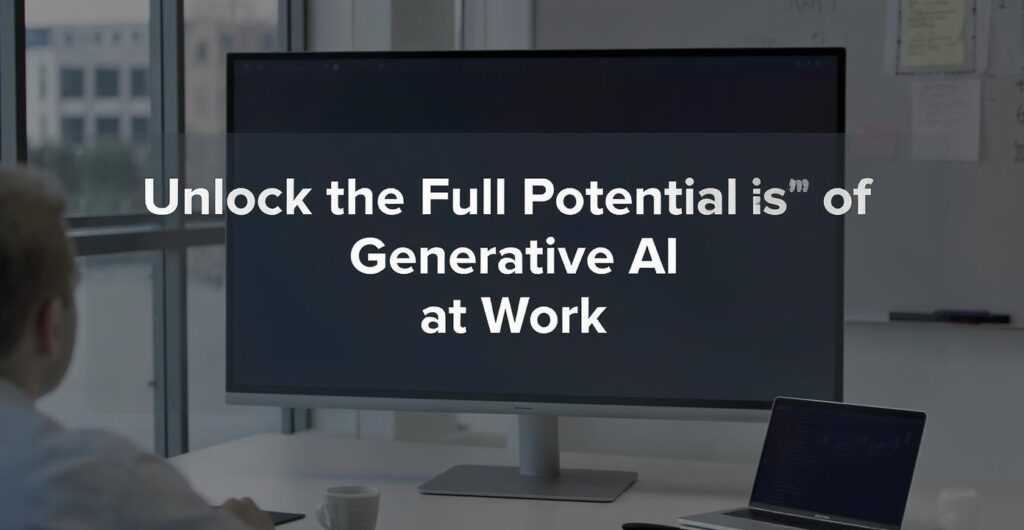In the era of digital acceleration, Generative AI is emerging as a key driver of innovation, efficiency, and transformation across enterprises. Businesses today face a growing imperative to embrace intelligent automation and machine-led creativity to remain competitive. To stay ahead, organizations must find ways to unlock the full potential of generative AI at work and integrate it across all functional areas—from operations to strategy, marketing to engineering.
Generative AI is no longer limited to experimental use. It’s becoming a core business enabler that can drive massive efficiency gains, enhance decision-making, and fuel a new era of human-AI collaboration. Companies that understand how to unlock its power stand to benefit from new levels of productivity, personalization, and performance.
What Is Generative AI and Why Does It Matter?
Generative AI refers to advanced machine learning models—often based on neural networks—that can produce new content, such as text, code, images, video, music, and more. These models are trained on massive datasets and can learn to mimic human-like patterns of creation. Tools like ChatGPT, DALL·E, and others are revolutionizing how work is performed by automating knowledge work.
To unlock the full potential of generative AI at work, businesses must deploy these technologies not just as tools for efficiency but as strategic assets that enhance creativity, problem-solving, and speed. From drafting legal documents to automating customer support, the possibilities are boundless.
Business Functions Transformed by Generative AI
Generative AI has proven use cases across virtually every department in an organization. Let’s explore how different business functions are leveraging generative AI:
Marketing and Content Creation
Generative AI allows marketers to produce blog posts, email campaigns, social media captions, whitepapers, and video scripts in a fraction of the time. AI tools can analyze customer preferences and generate personalized messages that drive engagement and conversions. To unlock the full potential of generative AI at work, marketing teams are using AI to reduce content creation costs while increasing output quality.
Sales and Customer Support
Sales professionals use AI to generate custom pitch decks, follow-up emails, and CRM summaries. Customer support teams use AI-powered chatbots that answer FAQs, troubleshoot issues, and even escalate cases to human agents when necessary. This improves resolution speed and customer satisfaction—core outcomes for competitive enterprises.
Software Development and Engineering
Developers are using generative AI tools to write code, detect bugs, and generate unit tests. This not only accelerates software development but also improves accuracy and reduces repetitive coding tasks. Teams that want to unlock the full potential of generative AI at work in IT are integrating these tools directly into CI/CD pipelines and development environments.
Human Resources and Recruitment
HR departments are automating job descriptions, onboarding documents, and employee communications using generative AI. AI can also screen resumes and assist with candidate shortlisting by matching skills and roles with high precision, improving hiring outcomes.
Finance, Legal, and Compliance
Financial analysts use AI to generate real-time reports, automate budgeting forecasts, and extract insights from transactional data. Legal teams deploy AI to draft contracts, summarize case files, and ensure compliance with regulatory standards. These applications not only save time but reduce the risk of human error.
The Benefits of Unlocking Generative AI in the Workplace
When organizations fully integrate generative AI into workflows, the benefits are substantial. Here are some of the top advantages:
Increased productivity: Automating routine and creative tasks frees employees to focus on strategic thinking.
Faster innovation: With AI, companies can rapidly prototype, iterate, and validate new ideas.
Cost savings: Reducing reliance on manual labor and repetitive tasks cuts operational costs.
Improved decision-making: AI-generated summaries, reports, and insights provide better data for leadership.
Enhanced customer experience: Personalized, instant interactions boost engagement and loyalty.
To consistently realize these advantages, businesses must commit to long-term strategies that unlock the full potential of generative AI at work.
How to Successfully Integrate Generative AI Across Teams
Successfully adopting generative AI in the workplace involves more than buying tools. It requires leadership vision, change management, and a commitment to continuous improvement. Here’s how to do it:
1. Define Clear Use Cases
Begin by identifying which tasks or processes can benefit the most from generative AI. Look for areas that are repetitive, time-consuming, or prone to human error. Prioritize use cases with measurable ROI.
2. Educate and Upskill Employees
To unlock the full potential of generative AI at work, your workforce needs to understand how to use it. Invest in AI training programs, workshops, and hands-on labs. Encourage a culture of experimentation.
3. Integrate with Existing Tools
Generative AI should not operate in a silo. Integrate it with the platforms your teams already use—whether it’s Salesforce, Microsoft 365, or GitHub. Seamless integration ensures faster adoption and efficiency gains.
4. Ensure Responsible AI Use
Build AI governance frameworks to address concerns like bias, privacy, and misinformation. Ensure transparency in AI decision-making and create escalation paths for human oversight.
5. Monitor and Optimize
Use data analytics to measure the impact of generative AI on productivity, output quality, and costs. Refine workflows based on insights and continuously optimize AI usage to ensure sustainable value.
Challenges That Can Limit AI Adoption
Despite its promise, several barriers prevent companies from realizing the full value of generative AI:
Lack of AI literacy among employees
Data quality and availability issues
Security and compliance concerns
Resistance to change
High costs of experimentation without clear ROI
Overcoming these challenges is critical to unlock the full potential of generative AI at work. Organizations must be willing to rethink processes, invest in upskilling, and foster a collaborative AI culture.
Real-World Impact of Generative AI in Business
Numerous organizations are already benefiting from enterprise-wide generative AI adoption:
A global financial firm reduced report writing time by 70% using generative AI tools.
A tech startup uses AI to generate software documentation, cutting development time in half.
A marketing agency tripled campaign output by automating ad copy and visual ideation.
An e-commerce company implemented AI-generated product descriptions across 10 languages, improving SEO and conversions.
Each example reflects a strategic commitment to unlock the full potential of generative AI at work, not just experiment with it.
The Future of Work Is AI-Augmented
As generative AI becomes more advanced, businesses will rely on it not just for support, but as a co-creator. We’re moving toward an era where AI can interpret real-time data, simulate decisions, and offer proactive recommendations. AI copilots will become standard in design, writing, coding, and data analysis.
Companies that are early adopters today will be the digital leaders tomorrow. By making AI a part of everyday work—not just a department initiative—organizations can prepare for a more dynamic and intelligent future.
Key Success Metrics to Track
To evaluate generative AI initiatives, organizations should track:
Reduction in task completion time
Increase in volume or quality of output
Employee adoption and satisfaction rates
Return on AI investment (ROI)
Decrease in operational costs
Customer engagement improvements
These metrics can help gauge whether efforts to unlock the full potential of generative AI at work are driving meaningful business value.
Steps to Future-Proof Your Business with Generative AI
Establish executive sponsorship to ensure strategic alignment.
Pilot across diverse departments to identify high-impact wins.
Document processes and lessons learned for repeatability.
Create internal AI champions who guide team adoption.
Partner with technology experts like Company name for seamless integration.
With a structured approach, any organization can transition from exploring AI to leading with it.
Read Full Article : https://bizinfopro.com/whitepapers/it-whitepaper/unlock-the-full-potential-of-generative-ai-at-work/
About Us : BizInfoPro is a modern business publication designed to inform, inspire, and empower decision-makers, entrepreneurs, and forward-thinking professionals. With a focus on practical insights and in‑depth analysis, it explores the evolving landscape of global business—covering emerging markets, industry innovations, strategic growth opportunities, and actionable content that supports smarter decision‑making.



